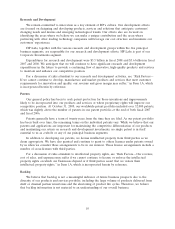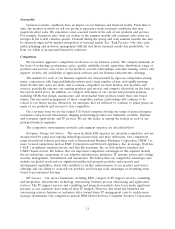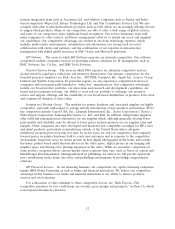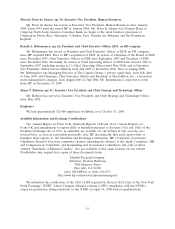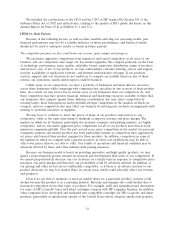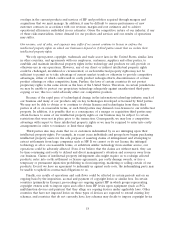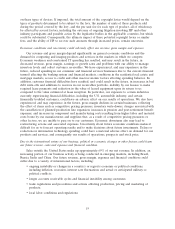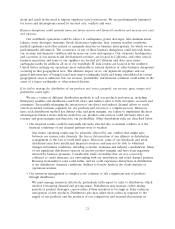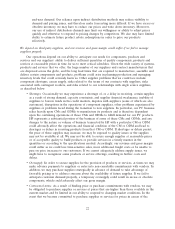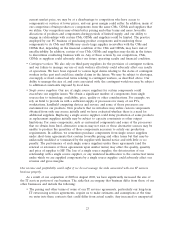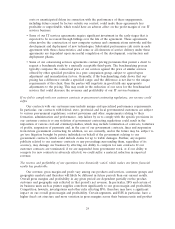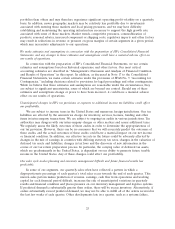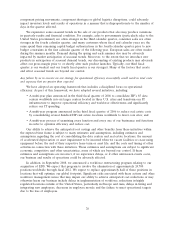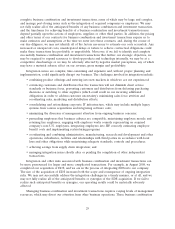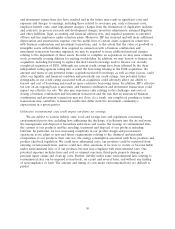HP 2008 Annual Report Download - page 26
Download and view the complete annual report
Please find page 26 of the 2008 HP annual report below. You can navigate through the pages in the report by either clicking on the pages listed below, or by using the keyword search tool below to find specific information within the annual report.• managing a geographically dispersed workforce;
• changes in the regulatory or legal environment;
• differing technology standards or customer requirements;
• import, export or other business licensing requirements or requirements relating to making
foreign direct investments, which could affect our ability to obtain favorable terms for
components or lead to penalties or restrictions;
• difficulties associated with repatriating cash generated or held abroad in a tax-efficient manner
and changes in tax laws; and
• fluctuations in freight costs and disruptions in the transportation and shipping infrastructure at
important geographic points of exit and entry for our products and shipments.
The factors described above also could disrupt our product and component manufacturing and key
suppliers located outside of the United States. For example, we rely on manufacturers in Taiwan for the
production of notebook computers and other suppliers in Asia for product assembly and manufacture.
As approximately 69% of our sales are from countries outside of the United States, other
currencies, particularly the euro, the British pound, Chinese Yuan Renminbi and the Japanese yen, can
have an impact on HP’s results (expressed in U.S. dollars). Currency variations also contribute to
variations in sales of products and services in impacted jurisdictions. Accordingly, fluctuations in foreign
currency rates, most notably the strengthening of the dollar against the euro, could have a material
impact on our revenue growth in future periods. In addition, currency variations can adversely affect
margins on sales of our products in countries outside of the United States and margins on sales of
products that include components obtained from suppliers located outside of the United States. We use
a combination of forward contracts and options designated as cash flow hedges to protect against
foreign currency exchange rate risks. Such hedging activities may be ineffective or may not offset more
than a portion of the adverse financial impact resulting from currency variations. Gains or losses
associated with hedging activities also may impact our revenue and to a lesser extent our cost of sales
and financial condition.
In many foreign countries, particularly in those with developing economies, it is common to engage
in business practices that are prohibited by laws and regulations applicable to us, such as the Foreign
Corrupt Practices Act. Although we implement policies and procedures designed to facilitate
compliance with these laws, our employees, contractors and agents, as well as those companies to which
we outsource certain of our business operations, may take actions in violation of our policies. Any such
violation, even if prohibited by our policies, could have a material adverse effect on our business.
Terrorist acts, conflicts and wars may seriously harm our business and revenue, costs and expenses and
financial condition and stock price.
Terrorist acts, conflicts or wars (wherever located around the world) may cause damage or
disruption to HP, our employees, facilities, partners, suppliers, distributors, resellers or customers. The
potential for future attacks, the national and international responses to attacks or perceived threats to
national security, and other actual or potential conflicts or wars, including the ongoing military
operations in Iraq, have created many economic and political uncertainties. In addition, as a major
multi-national company with headquarters and significant operations located in the United States,
actions against or by the United States may impact our business or employees. Although it is
impossible to predict the occurrences or consequences of any such events, they could result in a
decrease in demand for our products, make it difficult or impossible to deliver products to our
customers or to receive components from our suppliers, create delays and inefficiencies in our supply
20


